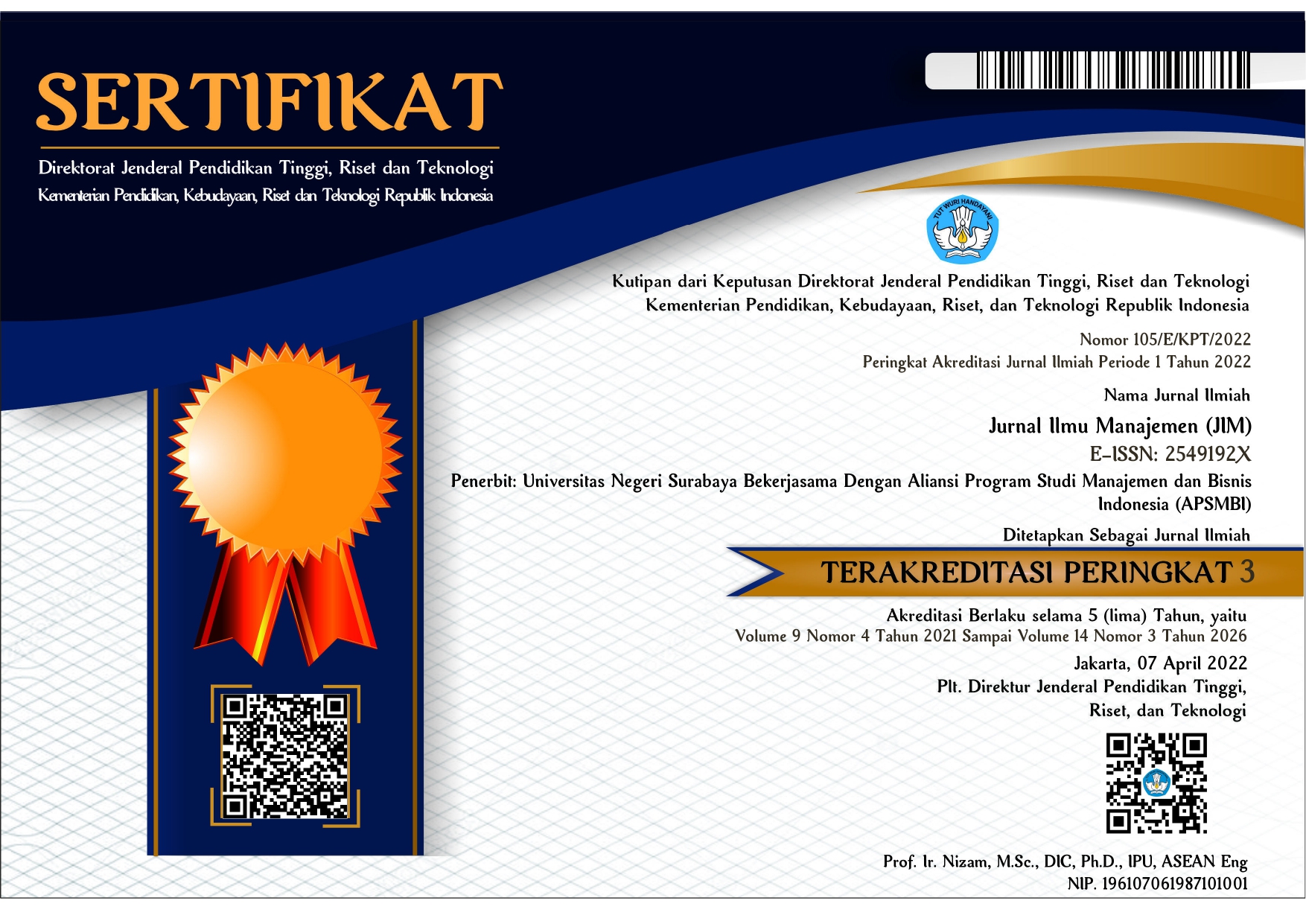Pengaruh Perceived Ease of Use dan Perceived Usefulness terhadap Loyalitas dengan Trust sebagai Variabel Intervening terhadap Penggunaan Aplikasi Warung Pintar
DOI:
https://doi.org/10.26740/jim.v10n3.p946-959Keywords:
perceived ease of use, perceived usefulness, trust, loyaltyAbstract
This study aims to determine the effect of perceived ease of use and perceived usefulness on loyalty with trust as an intervening variable. This study uses a quantitative approach. The sampling technique is a non-probability technique with the type of judgmental sampling. Data collection was done by distributing questionnaires. The number of respondents obtained as many as 245 people. The research method used is path analysis. The results obtained in this study are that perceived ease of use has a positive and significant effect on perceived usefulness. Perceived ease of use has a positive and significant effect on trust. Perceived usefulness has a positive effect on trust. Trust has a positive and significant effect on loyalty. Perceived ease of use has no effect on loyalty. And perceived usefulness has a positive and significant effect on loyalty. PT. Warung Pintar Distribusi is expected to pay more attention to reviews from partners regarding the use of aplikasi warung pintar and optimize the features in aplikasi warung pintar.
References
Aghdaie, S. F. A., Piraman, A., & Fathi, S. (2011). An analysis of factors affecting the consumer's attitude of trust and their impact on internet purchasing behavior. International Journal of Business and Social Science, 2(23).
Berita Kominfo. (2020). Survei Penetrasi Pengguna Internet di Indonesia Bagian Penting dari Transformasi Digital. (https://www.kominfo.go.id/content/detail/30653/dirjen-ppi-survei-penetrasi-pengguna-internet-di-indonesia-bagian-penting-dari-transformasi-digital/0/berita_satker di akses pada 15 September 2021)
Burhan, Fahmi. (2021). Naik 50%, Warung Pintar Targetkan Satu Juta Mitra Warung Tahun Depan. (https://katadata.co.id/intannirmala/digital/60e57989073cb/naik-50-warung-pintar-targetkan-satu-juta-mitra-warung-tahun-depan di akses pada 17 September 2021)
Chinomona, R. (2013), The in?uence of perceived ease-of-use and perceived usefulness on trust and intention to use mobile social software: technology and innovation. African Journal for Physical Health Education, Recreation and Dance, 19 (2), 258-273.
Cho, Yoon C. 2015. Exploring Factors That Affect Usefulness, Ease Of Use, Trust, And Purchase Intention In The Online Environment. International Journal of Management & Information Systems, 19 (1), 234-241.
Daeng, I.,N,Mewengkang., & Edmon, R . (2017). Penggunaan Smartphone Dalam Menunjang Aktivitas Perkuliahan Oleh Mahasiswa Fispol Unsrat Manado. e-journal "Acta Diurna", 4(1), 1-15.
Davis, F. D. (1989). Perceived Usefulness, Perceived Ease of Use, and User Acceptance of Information Technology. MIS Quarterly, 13 (5), 318-340.
Delgado-Ballester, E., Munuera-Aleman, J. L., & Yague-Guillen, M. J. (2003). Development and validation of a brand trust scale. International journal of market research, 45(1), 35-54.
D. Gefen, E. Karahanna, and D. W. Straub. (2003). Trust and TAM in online shopping: An integrated model. MIS Quarterly, 27(1), 51-90.
Fusilier, M and Durlabhji, S. (2005). An exploration of Student Internet Use in India (the technology acceptance model and the theory of planned behavior). Journal of Marketing, 22 (4).
Griffin, Jill. (2002). Customer Loyalty: How to Earn it, How to Keep it. New York: Simon and Chuster, Inc
Harrigan, M., Feddema, K., Wang, S., Harrigan, P., & Diot, E. (2021). How trust leads to online purchase intention founded in perceived usefulness and peer communication. Journal of Consumer Behaviour, 20(5), 1297-1312.
Karyose, H., Astuti, W., & Ferdiansjah, A. (2017). Customer loyalty: the effect of service quality, corporate image, customer relationship marketing and customer satisfaction as intervening variable-an empirical analysis of bank customers in Malang City. Marketing and Branding Research, 4 (4), 336-347.
Keni, K. (2020). How Perceived Usefulness and Perceived Ease-of-use Affecting Intent to Repurchase. Jurnal Manajemen, 24(3), 481-496
Lau, G. T., & Lee, S. H. (1999). Consumers' trust in a brand and the link to brand loyalty. Journal of Market-Focused Management, 4(4), 341-370.
Lin, C. C. (2013). Exploring the relationship between technology acceptance model and usability test. Information Technology and Management, 14(3), 243-255.
Liu, C. T., Guo, Y. M., & Lee, C. H. (2011). The effects of relationship quality and switching barriers on customer loyalty. International Journal of Information Management, 31(1), 71-79.
Malhotra, Naresh K., and David F. Birks. (2007). Marketing Research: An Applied Approach 3rd European Edition. Harlow, England: Prentice-Hall.
Mandasari, C. S., & Giantari, I. G. A. K. (2017). Pengaruh perceived usefulness, perceived ease of use, dan kualitas layanan terhadap kepuasan untuk membangun loyalitas. E-Jurnal Ekonomi Dan Bisnis Universitas Udayana, 10(6), 3637-3664.
Mayer, R. C., Davis, J. H., & Schoorman, F. D. (1995). An integrative model of organizational trust. Academy of management review, 20(3), 709-734.
Morgan, R. M., & Hunt, S. D. (1994). The commitment-trust theory of relationship marketing. Journal of marketing, 58(3), 20-38.
Mowen, J.C., dan Minor, M.S. (1998). Consumer Behavior and Marketing Strategy. New York : Mc Graw-Hill Companies.
Mu, H., & Lee, Y. (2017) Examining the Influencing Factors of Third-Party Mobile Payment Adoption: A Comparative Study of Alipay and WeChat Pay. Journal of Information Systems 26(4), 257-294
Natalia, J., & Ginting, D. B. (2018). Analisis Pengaruh Kelengkapan Fitur, Persepsi Kemudahan Penggunaan, Kualitas Informasi, Kualitas Sistem, Persepsi Manfaat terhadap Kepuasan Penggunaan serta Dampaknya terhadap Loyalitas Pengguna Aplikasi Viu. Media Informatika, 17(3), 148-164.
Nielsen, J. (1999). Designing Web Usability: The Practice of Simplicity. New Riders Publishing, Thousand Oaks.
Preacher, K. J., & Hayes, A. F. (2004). SPSS and SAS procedures for estimating indirect effects in simple mediation models. Behavior research methods, instruments, & computers, 36(4), 717-731.
Putri, K., & Usman, O. (2021). The Effect of Perceived of Ease, Perceived of Benefits and Perceived of Risk to Decisions on Use of Mobile Banking Students of the State University of Jakarta. SSRN Electronic Journal. http://dx.doi.org/10.2139/ssrn.3768004
Romla, S., & Ratnawati, A. (2018). Keputusan Pembelian E-Commerce Melalui Kemudahan Penggunaan, Kualitas Informasi Dan Kualitas Interaksi Layanan Web. Jurnal Ekonomi Dan Bisnis, 19(1), 59-70.
Singh. J., & Sirdeshmukh, D. (2000). Agency and trust mechanisms in consumer satisfaction and Loyalty Judgements. Journal of the Academy of Marketing Science, 28 (1), 150-167.
Tu, C. C., Fang, K., & Lin, C. Y. (2012). Perceived Ease of Use, Trust, and Satisfaction as Determinants of Loyalty in e-Auction Marketplace. J. Comput., 7(3), 645-652.
Veloutsou, Cleopatra. 2015. Brand Evaluation, Satisfaction, and Trust as Predictors of Brand Loyalty: The Mediator-Moderator Effect of Brand Relationships. Journal of Consumer Marketing 32 (6).405-421.
Wardhana, A., & Yulia, Y. (2020). Pengaruh kemudahan penggunaan, nilai tidak tergantikan, kualitas sistem, kesadaran teknologi dan desain visual terhadap positif word of mouth dan niat pembelian ulang dengan mediasi loyalitas merek. Managament Insight: Jurnal Ilmiah Manajemen, 15(1), 65-77.
We Are Social. (2021). Hootsuite (We Are Social): Indonesian Digital Report 2021. (https://andi.link/hootsuite-we-are-social-indonesian-digital-report-2021/, diakses pada 15 Oktober 2021)
Wilson, N., & Makmud, S. T. (2018). The Impact Of Brand Evaluation, Satisfaction, And Trust To Brand Loyalty: A Case Study Of The Indonesian Smartphone Industry. Jurnal Muara Ilmu Sosial, Humaniora, dan Seni, 2(2), 633-649.
Wilson, N. (2019). The Impact of Perceived Usefulness and Perceived Ease-of-Use toward Repurchase Intention in the Indonesian E-Commerce Industry, Jurnal Manajemen Indonesia. 19(3), 241-249.
Zikmund, W. G., JR, M. R., & Gilbert, F. W. (2003). Integrating Marketing Strategy and Information Technology. New Jersey: John Wiley and Sons
Downloads
Published
How to Cite
Issue
Section
License

This work is licensed under a Creative Commons Attribution-NonCommercial 4.0 International License.
 Abstract views: 1809
,
Abstract views: 1809
, PDF Downloads: 1965
PDF Downloads: 1965










